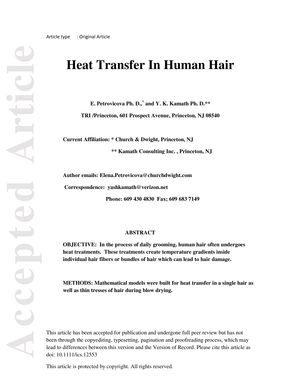TLDR Heat transfer in hair is slower in groups of hair, increasing the risk of damage from high-temperature styling tools.
The study developed mathematical models to analyze heat transfer in individual hairs and thin tresses during blow drying. It found that heat transfer in a single hair occurred quickly through conduction, while in a hair assembly, both conduction and convection were involved, resulting in slower heat transfer. Heat penetration to the center of a hair assembly took minutes rather than seconds. This model helped understand the potential for hair damage when using high-temperature styling devices like flat irons.
8 citations
,
August 1993 in “Colloid & Polymer Science” The observed "toughening" in keratin was actually due to water evaporation, not a real change in keratin.
 August 2025 in “Aesthetic Plastic Surgery”
August 2025 in “Aesthetic Plastic Surgery” Collaboration and innovation are key to developing effective, safe hair loss treatments.
 July 2024 in “Periodontology 2000”
July 2024 in “Periodontology 2000” Autologous platelet concentrates show promise in esthetic treatments but need more standardized research.
83 citations
,
August 2020 in “Resources” Macroalgae compounds offer sustainable, effective benefits for cosmetics.
 10 citations
,
May 2015 in “International Journal of Women's Dermatology”
10 citations
,
May 2015 in “International Journal of Women's Dermatology” New treatments for skin and hair disorders in women of color address unique biological differences and include specific acne medications, sunscreens, skin lighteners, and hair care adjustments.
 August 2024 in “International Journal of Basic & Clinical Pharmacology”
August 2024 in “International Journal of Basic & Clinical Pharmacology” Secretome-based therapies could improve hair growth better than current treatments.




